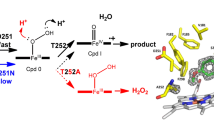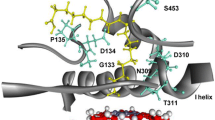Abstract
CYP101D2 is a cytochrome P450 monooxygenase from Novosphingobium aromaticivorans which is closely related to CYP101A1 (P450cam) from Pseudomonas putida. Both enzymes selectively hydroxylate camphor to 5-exo-hydroxycamphor, and the residues that line the active sites of both enzymes are similar including the pre-eminent Tyr96 residue. However, Met98 and Leu253 in CYP101D2 replace Phe98 and Val247 in CYP101A1, and camphor binding only results in a maximal change in the spin state to 40 % high-spin. Substitutions at Tyr96, Met98 and Leu253 in CYP101D2 reduced both the spin state shift on camphor binding and the camphor oxidation activity. The Tyr96Ala mutant increased the affinity of CYP101D2 for hydrocarbon substrates including adamantane, cyclooctane, hexane and 2-methylpentane. The monooxygenase activity of the Tyr96Ala variant towards alkane substrates was also enhanced compared with the wild-type enzyme. The crystal structure of the substrate-free form of this variant shows the enzyme in an open conformation (PDB: 4DXY), similar to that observed with the wild-type enzyme (PDB: 3NV5), with the side chain of Ala96 pointing away from the heme. Despite this, the binding and activity data suggest that this residue plays an important role in substrate binding, evidencing that the enzyme probably undergoes catalysis in a more closed conformation, similar to those observed in the crystal structures of CYP101A1 (PDB: 2CPP) and CYP101D1 (PDB: 3LXI).







Similar content being viewed by others
References
Atkins WM, Sligar SG (1988) The roles of active site hydrogen bonding in cytochrome P-450cam as revealed by site-directed mutagenesis. J Biol Chem 263:18842–18849
Bell SG, Wong LL (2007) P450 enzymes from the bacterium Novosphingobium aromaticivorans. Biochem Biophys Res Commun 360:666–672
Bell SG, Rouch DA, Wong LL (1997) Selective aliphatic and aromatic carbon-hydrogen bond activation catalysed by mutants of cytochrome P450(cam). J Mol Catal B-Enzym 3:293–302
Bell SG, Harford-Cross CF, Wong LL (2001a) Engineering the CYP101 system for in vivo oxidation of unnatural substrates. Protein Eng 14:797–802
Bell SG, Sowden RJ, Wong L-L (2001b) Engineering the haem monooxygenase cytochrome P450cam for monoterpene oxidation. Chem Commun 635–636. doi:10.1039/B100290M
Bell SG, Stevenson JA, Boyd HD, Campbell S, Riddle AD, Orton EL, Wong LL (2002) Butane and propane oxidation by engineered cytochrome P450cam. Chem Commun 490–491. doi:10.1039/B110957J
Bell SG, Chen X, Sowden RJ, Xu F, Williams JN, Wong LL, Rao Z (2003a) Molecular recognition in (+)-alpha-pinene oxidation by cytochrome P450cam. J Am Chem Soc 125:705–714
Bell SG, Chen X, Xu F, Rao Z, Wong LL (2003b) Engineering substrate recognition in catalysis by cytochrome P450cam. Biochem Soc Trans 31:558–562
Bell SG, Orton E, Boyd H, Stevenson JA, Riddle A, Campbell S, Wong LL (2003c) Engineering cytochrome P450cam into an alkane hydroxylase. Dalton Trans 2133–2140. doi:10.1039/B300869J
Bell SG, Hoskins N, Whitehouse CJC, Wong LL (2007) Design and engineering of cytochrome P450 systems, In: Sigel A, Sigel H, Sigel RKO (eds) The ubiquitous roles of cytochrome P450 proteins: metal ions in life sciences vol. 3 1st ed. John Wiley & Sons, Chichester, UK, pp 437–476
Bell SG, Dale A, Rees NH, Wong LL (2010) A cytochrome P450 class I electron transfer system from Novosphingobium aromaticivorans. Appl Microbiol Biotechnol 86:163–175
Bernhardt R (2006) Cytochromes P450 as versatile biocatalysts. J Biotechnol 124:128–145
Chen X, Christopher A, Jones JP, Bell SG, Guo Q, Xu F, Rao Z, Wong LL (2002) Crystal structure of the F87W/Y96F/V247L mutant of cytochrome P-450cam with 1,3,5-trichlorobenzene bound and further protein engineering for the oxidation of pentachlorobenzene and hexachlorobenzene. J Biol Chem 277:37519–37526
Chen VB, Arendall WB 3rd, Headd JJ, Keedy DA, Immormino RM, Kapral GJ, Murray LW, Richardson JS, Richardson DC (2010) MolProbity: all-atom structure validation for macromolecular crystallography. Acta Crystallogr D: Biol Crystallogr 66:12–21
Cryle MJ, Stok JE, De Voss JJ (2003) Reactions catalyzed by bacterial cytochromes P 450. Aust J Chem 56:749–762
Emsley P, Cowtan K (2004) Coot: model-building tools for molecular graphics. Acta Crystallogr D: Biol Crystallogr 60:2126–2132
Engh RA, Huber R (1991) Accurate bond and angle parameters for X-ray protein structure refinement. Acta Cryst A47:392–400
England PA, Rouch DA, Westlake ACG, Bell SG, Nickerson DP, Webberley M, Flitsch SL, Wong LL (1996) Aliphatic vs aromatic C-H bond activation of phenylcyclohexane catalysed by cytochrome P450cam. Chem Commun 357–358. doi:10.1039/CC9960000357
England PA, Harford-Cross CF, Stevenson JA, Rouch DA, Wong LL (1998) The oxidation of naphthalene and pyrene by cytochrome P450(cam). FEBS Lett 424:271–274
Fowler SM, England PA, Westlake ACG, Rouch DR, Nickerson DP, Blunt C, Braybrook D, West S, Wong LL, Flitsch SL (1994) Cytochrome P-450(CAM) monooxygenase can be redesigned to catalyze the regioselective aromatic hydroxylation of diphenylmethane. Chem Commun 2761–2762
Fredrickson JK, Brockman FJ, Workman DJ, Li SW, Stevens TO (1991) Isolation and characterization of a subsurface bacterium capable of growth on toluene, naphthalene, and other aromatic compounds. Appl Environ Microbiol 57:796–803
Fredrickson JK, Balkwill DL, Drake GR, Romine MF, Ringelberg DB, White DC (1995) Aromatic-degrading Sphingomonas isolates from the deep subsurface. Appl Environ Microbiol 61:1917–1922
Fredrickson JK, Balkwill DL, Romine MF, Shi T (1999) Ecology, physiology, and phylogeny of deep subsurface Sphingomonas sp. J Ind Microbiol Biotechnol 23:273–283
Grogan G (2011) Cytochromes P450: exploiting diversity and enabling application as biocatalysts. Curr Opin Chem Biol 15:241–248
Guengerich FP (2001) Common and uncommon cytochrome P450 reactions related to metabolism and chemical toxicity. Chem Res Toxicol 14:611–650
Harford-Cross CF, Carmichael AB, Allan FK, England PA, Rouch DA, Wong LL (2000) Protein engineering of cytochrome p450(cam) (CYP101) for the oxidation of polycyclic aromatic hydrocarbons. Protein Eng 13:121–128
Hayashi T, Harada K, Sakurai K, Shimada H, Hirota S (2009) A role of the heme-7-propionate side chain in cytochrome P450cam as a gate for regulating the access of water molecules to the substrate-binding site. J Am Chem Soc 131:1398–1400
Isin EM, Guengerich FP (2007) Complex reactions catalyzed by cytochrome P450 enzymes. Biochim Biophys Acta 1770:314–329
Jones JP, O'Hare EJ, Wong LL (2001) Oxidation of polychlorinated benzenes by genetically engineered CYP101 (cytochrome P450(cam)). Eur J Biochem 268:1460–1467
Kadkhodayan S, Coulter ED, Maryniak DM, Bryson TA, Dawson JH (1995) Uncoupling oxygen transfer and electron transfer in the oxygenation of camphor analogues by cytochrome P450-CAM. Direct observation of an intermolecular isotope effect for substrate C-H activation. J Biol Chem 270:28042–28048
Katagiri M, Ganguli BN, Gunsalus IC (1968) A soluble cytochrome P-450 functional in methylene hydroxylation. J Biol Chem 243:3543–3546
Lee YT, Wilson RF, Rupniewski I, Goodin DB (2010) P450cam visits an open conformation in the absence of substrate. Biochemistry 49:3412–3419
Loida PJ, Sligar SG (1993) Molecular recognition in cytochrome P-450: mechanism for the control of uncoupling reactions. Biochemistry 32:11530–11538
Ma M, Bell SG, Yang W, Hao Y, Rees NH, Bartlam M, Zhou W, Wong LL, Rao Z (2011) Structural analysis of CYP101C1 from Novosphingobium aromaticivorans DSM12444. ChemBioChem 12:88–99
Manna SK, Mazumdar S (2010) Tuning the substrate specificity by engineering the active site of cytochrome P450cam: a rational approach. Dalton Trans 39:3115–3123
McCoy AJ, Grosse-Kunstleve RW, Adams PD, Winn MD, Storoni LC, Read RJ (2007) Phaser crystallographic software. J Appl Crystallogr 40:658–674
Monti D, Ottolina G, Carrea G, Riva S (2011) Redox reactions catalyzed by isolated enzymes. Chem Rev 111:4111–4140
Murshudov GN, Vagin AA, Dodson EJ (1997) Refinement of macromolecular structures by the maximum-likelihood method. Acta Crystallogr D: Biol Crystallogr 53:240–255
Nickerson DP, Harford-Cross CF, Fulcher SR, Wong LL (1997) The catalytic activity of cytochrome P450(cam) towards styrene oxidation is increased by site-specific mutagenesis. FEBS Lett 405:153–156
Oprea TI, Hummer G, Garcia AE (1997) Identification of a functional water channel in cytochrome P450 enzymes. Proc Natl Acad Sci U S A 94:2133–2138
Ortiz de Montellano PR (ed) (2005) Cytochrome P450: structure, mechanism, and biochemistry, 3rd edn. Kluwer Academic/Plenum Press, New York
Otwinowski ZWM (1997) Processing of X-ray diffraction data collected in oscillation mode. Methods Enzymol 276:307–326
Poulos TL, Finzel BC, Howard AJ (1987) High-resolution crystal structure of cytochrome P450cam. J Mol Biol 195:687–700
Raag R, Poulos TL (1991) Crystal structures of cytochrome P-450CAM complexed with camphane, thiocamphor, and adamantane: factors controlling P-450 substrate hydroxylation. Biochemistry 30:2674–2684
Robin A, Kohler V, Jones A, Ali A, Kelly PP, O'Reilly E, Turner NJ, Flitsch SL (2011) Chimeric self-sufficient P450cam-RhFRed biocatalysts with broad substrate scope. Beilstein J Org Chem 7:1494–1498
Romine MF, Fredrickson JK, Li SM (1999a) Induction of aromatic catabolic activity in Sphingomonas aromaticivorans strain F199. J Ind Microbiol Biotechnol 23:303–313
Romine MF, Stillwell LC, Wong KK, Thurston SJ, Sisk EC, Sensen C, Gaasterland T, Fredrickson JK, Saffer JD (1999b) Complete sequence of a 184-kilobase catabolic plasmid from Sphingomonas aromaticivorans F199. J Bacteriol 181:1585–1602
Sambrook J, Fritsch EF, Maniatis T (1989) Molecular cloning: a laboratory manual, 2nd edn. Cold Spring Harbor Laboratory Press, New York
Savino C, Montemiglio LC, Sciara G, Miele AE, Kendrew SG, Jemth P, Gianni S, Vallone B (2009) Investigating the structural plasticity of a cytochrome P450: three-dimensional structures of P450 EryK and binding to its physiological substrate. J Biol Chem 284:29170–29179
Scott EE, He YA, Wester MR, White MA, Chin CC, Halpert JR, Johnson EF, Stout CD (2003) An open conformation of mammalian cytochrome P450 2B4 at 1.6-A resolution. Proc Natl Acad Sci USA 100:13196–13201
Sigel A, Sigel H, Sigel R (ed) (2007) The ubiquitous roles of cytochrome P450 proteins, 1st ed. John Wiley & Sons, Chichester, UK
Sowden RJ, Yasmin S, Rees NH, Bell SG, Wong LL (2005) Biotransformation of the sesquiterpene (+)-valencene by cytochrome P450(cam) and P450(BM-3). Org Biomol Chem 3:57–64
Speight RE, Hancock FE, Winkel C, Bevinakatti HS, Sarkar M, Flitsch SL, Turner NJ (2004) Rapid identification of cytochrome P450(cam) variants by in vivo screening of active site libraries. Tetrahedron-Asymmetry 15:2829–2831
Stevenson JA, Westlake ACG, Whittock C, Wong LL (1996) The catalytic oxidation of linear and branched alkanes by cytochrome P450(cam). J Am Chem Soc 118:12846–12847
Stevenson JA, Bearpark JK, Wong LL (1998) Engineering molecular recognition in alkane oxidation catalysed by cytochrome P450(cam). New J Chem 22:551–552
Weber E, Seifert A, Antonovici M, Geinitz C, Pleiss J, Urlacher VB (2011) Screening of a minimal enriched P450 BM3 mutant library for hydroxylation of cyclic and acyclic alkanes. Chem Commun 47:944–946
White RE, McCarthy MB, Egeberg KD, Sligar SG (1984) Regioselectivity in the cytochromes P-450: control by protein constraints and by chemical reactivities. Arch Biochem Biophys 228:493–502
Whitehouse CJ, Bell SG, Wong LL (2012) P450(BM3) (CYP102A1): connecting the dots. Chem Soc Rev 41:1218–1260
Williams JW, Morrison JF (1979) The kinetics of reversible tight-binding inhibition. Methods Enzymol 63:437–467
Winn MD, Ballard CC, Cowtan KD, Dodson EJ, Emsley P, Evans PR, Keegan RM, Krissinel EB, Leslie AG, McCoy A, McNicholas SJ, Murshudov GN, Pannu NS, Potterton EA, Powell HR, Read RJ, Vagin A, Wilson KS (2011) Overview of the CCP4 suite and current developments. Acta Crystallogr D: Biol Crystallogr 67:235–242
Xu F, Bell SG, Lednik J, Insley A, Rao Z, Wong LL (2005) The heme monooxygenase cytochrome P450cam can be engineered to oxidize ethane to ethanol. Angew Chem Int Ed Engl 44:4029–4032
Yang W, Bell SG, Wang H, Zhou W, Hoskins N, Dale A, Bartlam M, Wong LL, Rao Z (2010) Molecular characterization of a class I P450 electron transfer system from Novosphingobium aromaticivorans DSM12444. J Biol Chem 285:27372–27384
Yang W, Bell SG, Wang H, Zhou W, Bartlam M, Wong LL, Rao Z (2011) The structure of CYP101D2 unveils a potential path for substrate entry into the active site. Biochem J 433:85–93
Author information
Authors and Affiliations
Corresponding authors
Electronic supplementary material
Below is the link to the electronic supplementary material.
ESM 1
(PDF 1290 kb)
Rights and permissions
About this article
Cite this article
Bell, S.G., Yang, W., Dale, A. et al. Improving the affinity and activity of CYP101D2 for hydrophobic substrates. Appl Microbiol Biotechnol 97, 3979–3990 (2013). https://doi.org/10.1007/s00253-012-4278-7
Received:
Revised:
Accepted:
Published:
Issue Date:
DOI: https://doi.org/10.1007/s00253-012-4278-7




